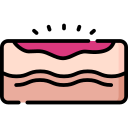Does the wound need cleansing?
- Only cleanse if there is visible debris on the wound bed that needs removed.
- Use warm potable tap water or warmed sterile solutions if immunocompromised such as saline 0.9%.
- PHMB if infected, colonised.
Welcome to the Right Decision Service (RDS) newsletter for April 2024.
Tactuum has been working hard to address the issues experienced during the last week. They have identified a series of three mitigation measures and put the first of these in place on Friday 3rd May. If this does not resolve the problems, the second mitigation will be actioned, and then the third if necessary.
Please keep a lookout for any slowing down of the system or getting locked out. Please email myself, mbuchner@tactuum.com and onivarova@tactuum.com if you experience any problems, and also please raise an urgent support ticket via the Support Portal.
Thank you for your patience and understanding while we achieve a full resolution.
A rotating carousel presenting some of the key RDS tools and capabilities, and an editable slideset, are now available in the Resources for RDS providers section of the Learning and Support toolkit.
The redesign of RDS Search and Browse is still on-track for delivery by mid-June 2024. We then plan to have a 3-week user acceptance testing phase before release to live. All editors and toolkit owners on this mailing list will be invited to participate in the UAT.
The archiving and version control functionality is also progressing well and we will advise on timescales for user acceptance testing shortly.
Tactuum is also progressing with the deep linking to individual toolkits within the mobile RDS app. There are several unknowns around the time and effort required for this work, which will only become clear as the work progresses. So we need to be careful to protect budget for this purpose.
These have all been compiled and effort estimated. Once the redesign work is complete, these will be prioritised in line with the remaining budget. We expect this to take place around late June.
Many thanks to those of you completed the value and impact survey we distributed in February. Here are some key findings from the 65 responses we received.
Figure 1: Impact of RDS on direct delivery of care
Key figures
Figure 2 shows RDS impact to date on delivery of health and care services
Key figures
These data show how RDS is already contributing to NHS reform priorities and supporting delivery of more sustainable care.
Saving time and money
Quality assurance and governance
Service innovation and workforce development
A few examples of toolkits published to live in the last month:
Some of the toolkits the RDS team is currently working on:
Please contact his.decisionsupport@nhs.scot if you would like to learn more about a toolkit. The RDS team will put you in touch with the relevant toolkit lead.
Thanks to all of you who have responded to the retrospective quality audit survey and to the follow up questions. We still have some following up to do, and to work with owners of a further 23 toolkits to complete responses. An interim report is being presented to the HIS Quality and Performance Committee.
Eight clinical services and two public library services are undertaking tests of change to implement the Being a partner in my care app. This app aims to support patients and the public to become active participants in Realistic Medicine. It has a strong focus on personalised, person-centred care and a library of shared decision aids, as well as simple explanations and videoclips to help the public to understand the aims of Realistic Medicine. The tests of change will inform guidance and an implementation model around wider adoption and spread of the app.
With kind regards
Right Decision Service team
Healthcare Improvement Scotland

Social care workers in care homes and care at home services will not carry out full wound assessments. However, this tool will help you to describe a wound to nursing staff and other clinical colleagues so that appropriate action can be taken.
This chart is provided by Healthcare Improvement Scotland. The National Association of Tissue Viability Nurse Specialists NATVNS (Scotland) examined this resource in 2019. It is due for review.
The visual guide can be accessed here.
This guide presumes that Standard Infection Control Precautions (SICPs) are applied at all times when providing healthcare when there is a risk of exposure to blood, other body fluids, secretions or excretions (except sweat), non-intact skin or mucous membranes.
Does the wound need cleansing?
A. What tissue type and levels of exudate does the wound have?
B. Select secondary dressing if required.
Document in wound chart
A wound chart must be completed for every patient/client with a wound.
Points to remember:
© Healthcare Improvement Scotland 2021
Published February 2021
This document is licensed under the Creative Commons Attribution-Noncommercial-NoDerivatives 4.0 International Licence. This allows for the copy and redistribution of this document as long as Healthcare Improvement Scotland is fully acknowledged and given credit. The material must not be remixed, transformed or built upon in any way. To view a copy of this licence, visit https://creativecommons.org/licenses/by-nc-nd/4.0/
www.healthcareimprovementscotland.org